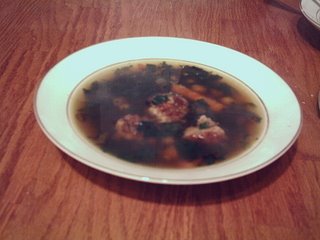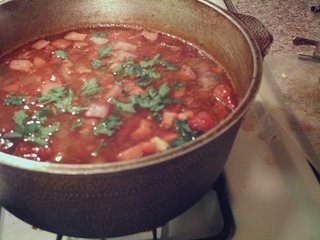
Behold, my first borsch. Not the first I’ve ever had, of course, but the first one I made all by myself. I tried to make an authentic borsch-—beefy and beety—-and I think I succeeded.
Whenever I cook something Russian, I consult my usual sources: my mom, Anya von Bremzen’s
Please to the Table,
Helen Rennie (who occasionally posts authentic and yummy-looking Russian recipes) and two other Russian cookbooks I own (not nearly as good as von Bremzen’s). I’d bet that every Russian family has its own way of making this beet and cabbage soup, and I cribbed ideas for my borsch from at least half a dozen recipes.
The ingredients and proportions I got from von Bremzen and Helen; the technique is mostly my mom’s. As usual, I did not measure my ingredients precisely, so this is more of an annotated field guide than a recipe. Finally, if you’ve never had borsch, please don’t let the words “beets” and “cabbage” scare you. Borsch is not a boiled vegetable soup; when made correctly, it is hearty, beefy and zesty.
For the stock, which I made a day in advance, I used a pound of
beef chuck, a couple of
beef marrow bones, a
soup bone, and some carrots and onions. These I covered with 4-5 quarts of water, brought it to a gentle boil, and then simmered for three hours, removing the scum from the surface as necessary. Quite a few recipes suggest using a ham bone in the stock as well, a good idea. The stock served its purpose, but I next time I want something meatier and beefier. I used too much water, too—3 quarts is enough, I think. Anyway, once the stock cooled, I refrigerated it overnight.

While I was making stock, I washed and trimmed 3 medium
beets. I covered them with water in a saucepan and simmered them for 50-60 minutes. Beets are done when you can pretty easily pierce them with a knife.
The next day I degreased the stock, threw out the bones, cut the cooked beef chuck into 1-inch cubes and added it back to the stock. I brought about 3 quarts of stock to a simmer in a big soup pot. Why three quarts? My big soup pot wasn’t nearly big enough to hold all of it (see above photo). The rest of the ingredients turned out to be proportionate to the amount of stock I did use, though.
While waiting for the stock to come a simmer, I grated the beets and put them in a saucepan with a 14-ounce can of crushed
tomatoes, half a 6-ounce can of
tomato paste, a big pinch of
salt, sugar, and a splash of
red wine vinegar. I simmered this on low heat, stirring occasionally. Did you know that beets and tomatoes are surprisingly delicious combination?
When the stock came to a gentle boil, I added a
bay leaf and 3 medium peeled and cubed
potatoes to the soup pot. While the potatoes were cooking—about 15-20 minutes—I finely shredded ½ pound of
cabbage (about ¼ head of a medium cabbage). I also diced 2 big
onions, 4 medium
carrots, a
green pepper, and crushed 4 cloves of
garlic. ( A note on the green pepper: my mom’s and von Bremzen’s recipes call for it; others don’t. I say, use green peppers if you like them—I do—and forget them if you don’t. )
When the potatoes were almost done, I added the cabbage to the soup pot. Meanwhile, I sautéed the onions, carrots and pepper in
sunflower oil until the onions were soft and golden—15 to 20 minutes or so. I stirred in the garlic at the end. When the cabbage was soft, about 20 minutes later, I added the aromatics to the soup pot, along with a tablespoon and a half of salt. All this simmered for 5 minutes, then the beet/tomato mixture went into the pot. I let the soup simmer for 10 more minutes. I also added a small handful of
black peppercorns to the pot.
Then I came to the part when, in my family, everyone stands around the soup pot and tastes the borsch while my mom asks, “What’s missing? Salt, sugar, acidity?” My borsch was missing all of these, so it was time to add a little of each, stir, taste again, and repeat until satisfied. I put some more tomato paste into a little bowl, along with a splash of tomato juice left over from the canned tomatoes, a splash of vinegar (substitute lemon juice), a splash of soup liquid, a dash of sugar and salt, and a heaping teaspoon of so
adjika.
Adjika is a very spicy Georgian vegetable relish that’s sold in Russian/Eastern European stores. Do borsh recipes generally call for adjika? No. Can you use it to give your borsch a little kick? Yes. My mom sometimes uses
lutenitsa, a vegetable spread, also sold in Russian groceries. Should you use, say, salsa, to flavor your borsch? I say no; it’s not at all authentic. Can you use a vegetable fix-in of Eastern European origin? I say yes, if it’s tomato-and-pepper-based. Don’t worry if you have neither adjika or lutenitsa; all you really need is tomato paste, sugar, salt, and vinegar or lemon juice.
I’d estimate that I used 2 teaspoons of sugar, a tablespoon of vinegar, and a 6-ounce can of tomato paste to flavor my borsch. Taste and repeat, taste and repeat. Before serving, try adding a couple of raw, crushed garlic cloves to the pot. Borsch should strike a nice balance between sweet and sour, tomato-y and beety, salty and zesty, with a little kick that comes from the crushed garlic or adjika.
Serve borsch with chopped
dill or
parsley, and
sour cream. Bread is essential; good
rye bread is preferable. Everyone tells me that you’re supposed to stir sour cream into the borsch, but I like to leave a thick clump in the middle of my soup bowl and swipe at it with each tablespoon. This borsch is even better on the second day, keeps for a week in the fridge, and feeds a small
kolhoz.
 Sorry for the long silence, guys. Oh, I’ve been cooking, but I haven’t made anything exciting in weeks. Nothing that’s inspired me to write a post that’s longer than 140 characters. (See my Twitter feed, at right, for the latest in Yulinka Cooks non-news.)
Sorry for the long silence, guys. Oh, I’ve been cooking, but I haven’t made anything exciting in weeks. Nothing that’s inspired me to write a post that’s longer than 140 characters. (See my Twitter feed, at right, for the latest in Yulinka Cooks non-news.)



 For the noodles, my recipe had you put 1.75 cups flour and ½ tsp. kosher salt in a large bowl. Then you make a well, and add 1 slightly beaten egg, ¼ cup water and 1 tbs. oil. Mix with your hands until the flour and liquids are combined. On a floured surface, knead the dough with the backs of your hands for at least five minutes.
For the noodles, my recipe had you put 1.75 cups flour and ½ tsp. kosher salt in a large bowl. Then you make a well, and add 1 slightly beaten egg, ¼ cup water and 1 tbs. oil. Mix with your hands until the flour and liquids are combined. On a floured surface, knead the dough with the backs of your hands for at least five minutes. 











 Eating them as a prelude to this creamy mushroom soup made with dried and fresh mushrooms, chicken stock, goat cheese, potatoes and just a hint of bacon for that smoky flavor.
Eating them as a prelude to this creamy mushroom soup made with dried and fresh mushrooms, chicken stock, goat cheese, potatoes and just a hint of bacon for that smoky flavor.

















